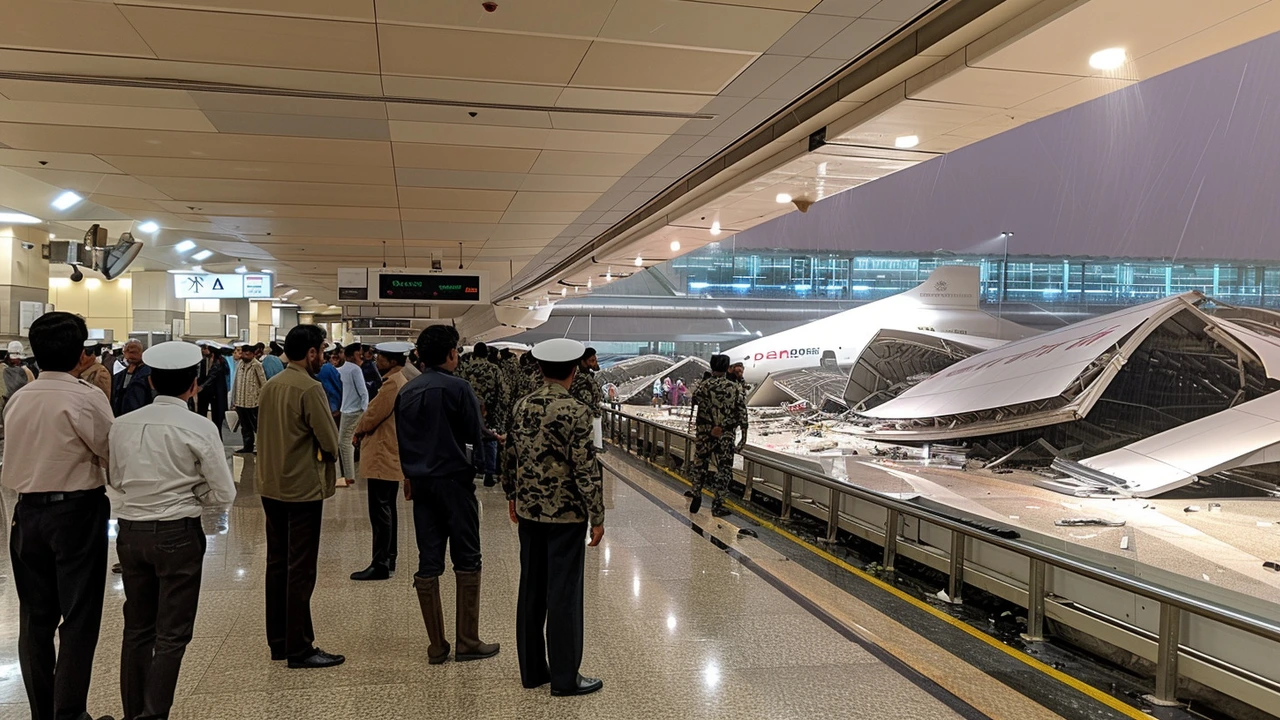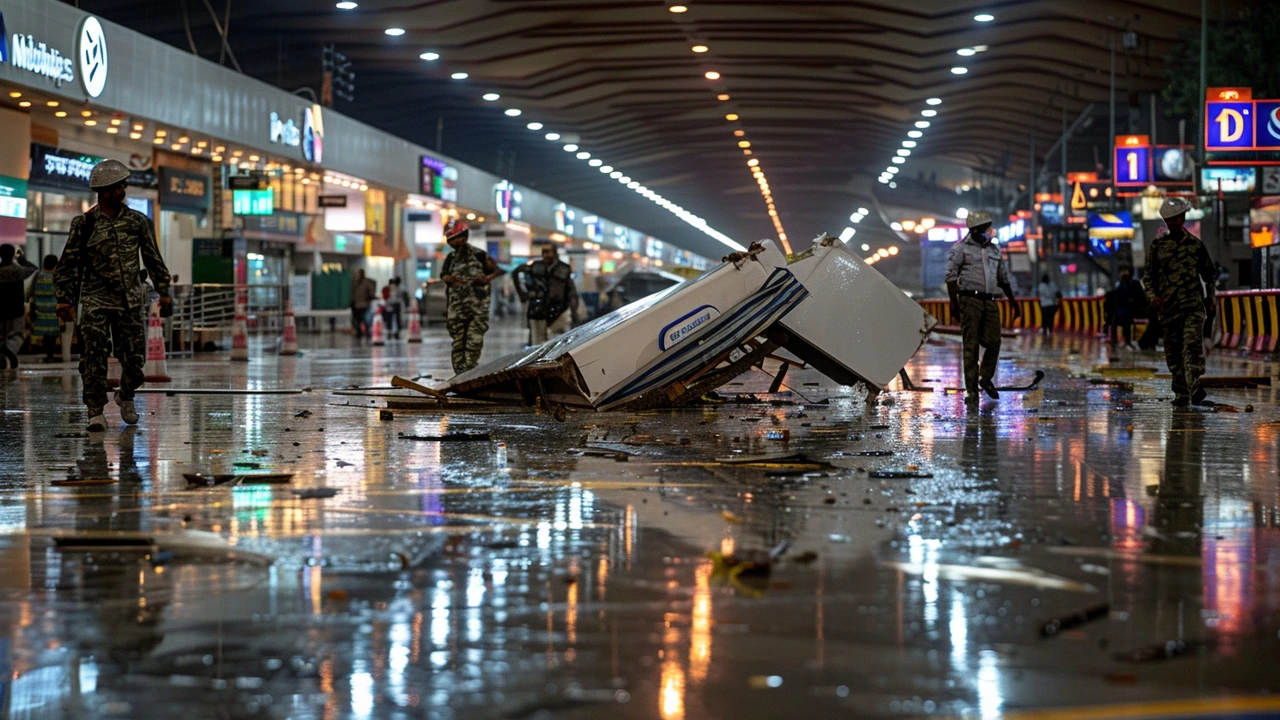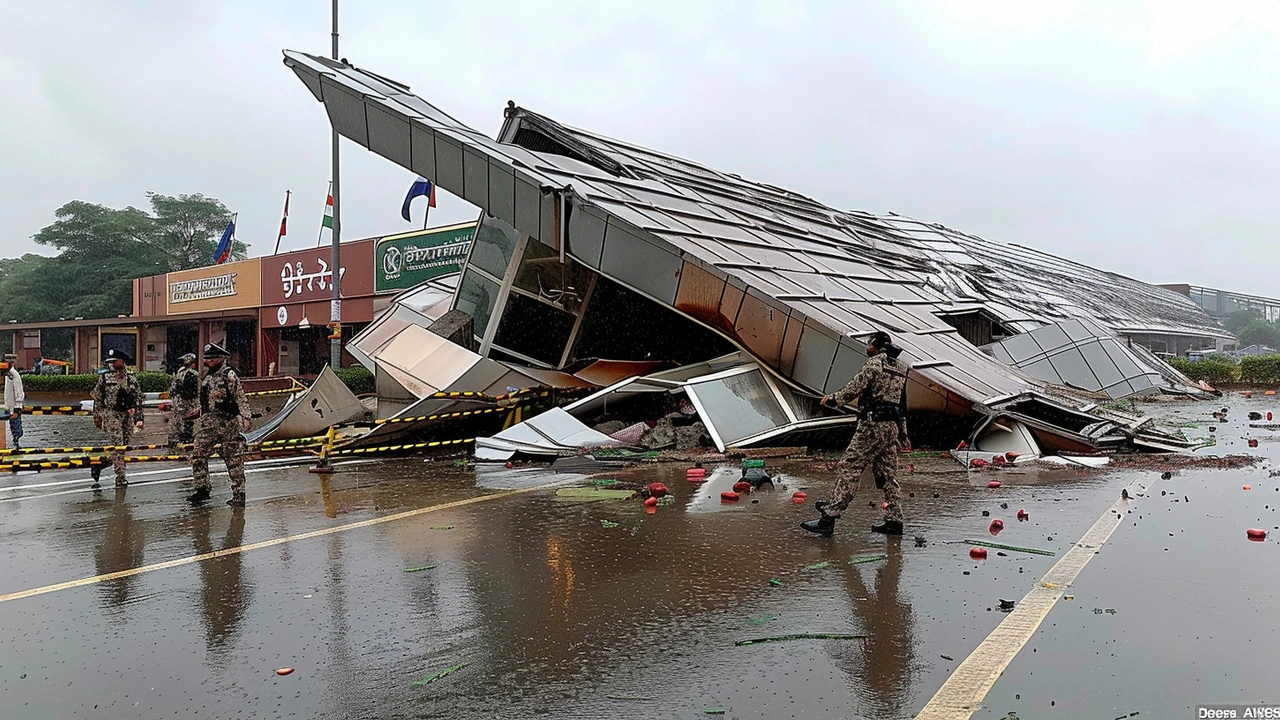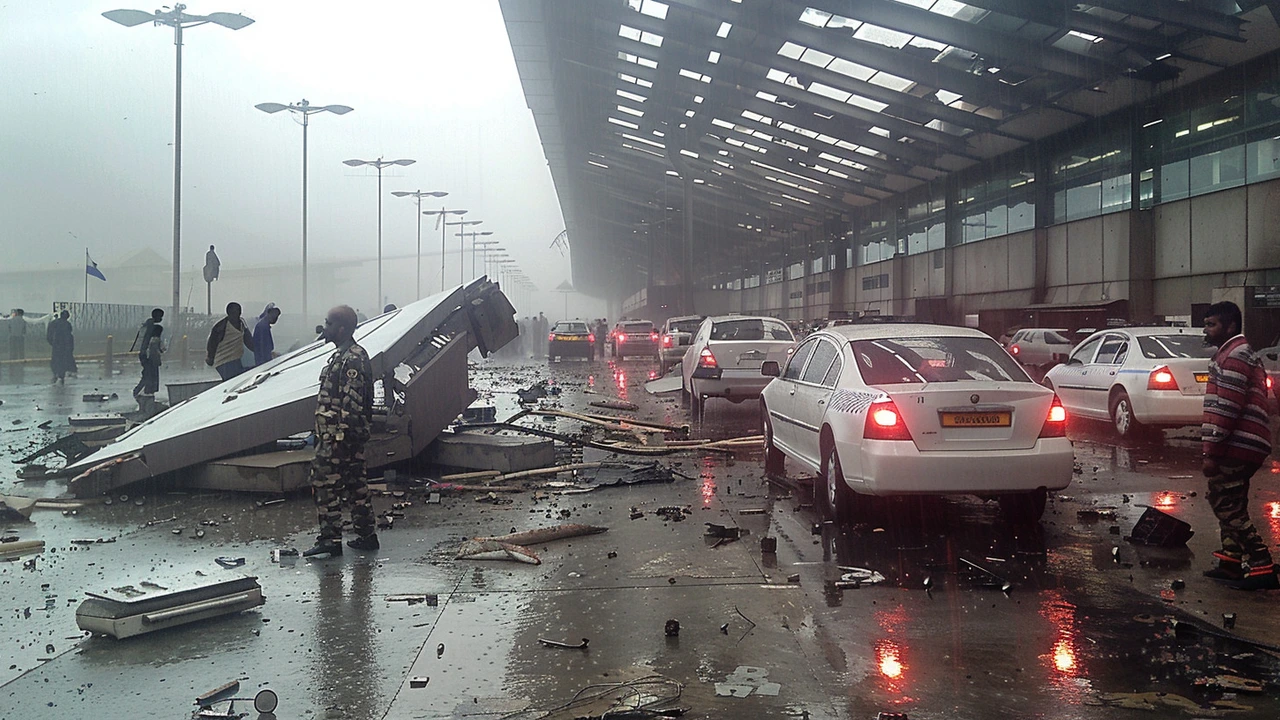Tragic Roof Collapse at Delhi Airport T1: One Dead, Eight Injured
On June 28, 2024, a shocking and tragic event unfolded at Terminal 1 (T1) of Delhi's Indira Gandhi International Airport. Due to the onslaught of heavy rains, a portion of the terminal’s roof collapsed, leading to one fatality and eight injured individuals. This incident has not only shocked the city but has also raised significant concerns about airport infrastructure safety.
Larsen and Toubro (L&T) Issues Clarification
In the wake of the incident, there was immediate speculation regarding the parties responsible for the construction and maintenance of the roof that collapsed. Larsen and Toubro (L&T), a major player in the construction industry, issued a clarification. The company stated unequivocally that it was neither involved in constructing the portion of the roof that collapsed nor responsible for its maintenance. L&T also extended its deepest sympathies to the families of those affected by the tragic event.
L&T’s Role in T1 Development
L&T's clarification further pointed out the specifics of their involvement with Terminal 1. The company had undertaken an expansion project for T1 in 2019, commissioned by the Delhi International Airport Limited (DIAL). This expansion work, which was completed and handed over in March 2024, was conducted in a section approximately 110 meters away from where the collapse occurred. L&T confirmed that the structural failure had no impact on this newly constructed and structurally sound extended portion of the terminal.

Impact on Airport Operations
The collapse at T1 has caused significant disruption. Delhi Airport is one of India's busiest airports, commanding an average of 1,400 flights daily across its three terminals: T1, T2, and T3. With Terminal 1 now closed until further notice, flight operations have been subsequently suspended, causing delays and inconvenience to numerous passengers. The closure of T1 indicates the severity of the incident and the imperative to conduct thorough safety inspections and repairs before normal operations can resume.
Concerns Over Airport Infrastructure Safety
This tragic event has triggered a broader discussion about the safety and integrity of aging infrastructure within airports across India. Airports have to withstand varied weather conditions and handle a considerable amount of daily human traffic, emphasizing the need for regular maintenance and upgrades. The collapse at T1 underlines the urgent need for updated safety protocols and stringent checks to catch structural weaknesses before they lead to such catastrophic outcomes.
Previous Incident and Historical Context
Regrettably, the incident at T1 is not an isolated event. Similar concerns were raised in 2017 when reports of leakage issues and minor structural damages at the same terminal came to light. Although repairs were made at that time, the current incident calls into question the efficacy and thoroughness of those interventions. It is crucial that this incident becomes a wake-up call for airport authorities nationwide to re-examine their infrastructures and reinforce them adequately.

Moving Forward: Ensuring Safety
For now, the focus remains on the immediate aftermath—securing the site, aiding those affected, and investigating the cause of the collapse. Delhi International Airport Limited (DIAL) has launched a comprehensive investigation into the incident to understand the root cause and prevent future occurrences. Alongside looking for accountability, there is also a call for implementing advanced systems and technologies that can predict and prevent structural failures before they manifest into disasters.
Furthermore, there is a pressing need for routine and rigorous inspections of all structural elements within the terminal buildings, especially in areas susceptible to weather-induced stress. Proactive measures, like the enhancement of drainage systems to prevent waterlogging, could significantly mitigate risks during heavy rains.
Flights and Passenger Information
Customers planning to fly from or to Terminal 1 are advised to stay updated with the latest information from airlines and the airport authorities. Alternative arrangements are being made by the airlines to accommodate affected passengers, but a temporary setback is inevitable. Passengers are encouraged to reach out to their respective airlines for rebooking options and the latest operational updates.
Industry Repercussions
The collapse has also drawn a lot of scrutiny from industry stakeholders and regulatory bodies. Aviation authorities are likely to implement more stringent guidelines and increase the frequency of inspections in light of this mishap. The event may also lead to an accelerated push towards modernizing airport infrastructure across the country, adopting designs and materials that can enhance both safety and durability.

The Path Ahead
In wrapping up, the tragic collapse at Terminal 1 of Delhi Airport serves as a grim reminder of the importance of robust infrastructure. As investigations proceed and findings surface, the hopes are that lessons will be learned and acted upon. This incident has not only affected those directly involved but has also rippled out to remind us all of the fragility and importance of safety in public infrastructure. As Delhi Airport works towards resuming normal operations, the eyes of many will be on how effectively the safety protocols are reviewed and fortified to prevent such tragedies in the future.






Edward Garza
June 29, 2024 AT 20:39The roof failure under heavy rain highlights the urgent need for proper drainage design at Delhi’s T1.
Allen Rodi
June 30, 2024 AT 14:20From an operational standpoint, the temporary shutdown of T1 means airlines have to reroute flights to T2 and T3, which can cause cascading delays across the network.
Passengers should keep an eye on airline notifications and consider flexible tickets if possible.
Jody Webster
July 1, 2024 AT 09:46Wow!!! The rain really did a number on the roof???!! I kinda think maybe the designers mis‑read the blueprints??! maybe??
Steve Goodger
July 2, 2024 AT 08:00It is truly heartbreaking to hear about the loss of life and injuries resulting from the roof collapse at Delhi’s Terminal 1, and my thoughts go out to the affected families.
When we examine infrastructure failures, it is essential to look beyond the immediate cause and consider systemic issues such as maintenance regimes, design standards, and climate resilience.
India’s airport network has expanded rapidly in recent years, yet many older structures have not been upgraded to cope with increasingly severe weather events.
The heavy monsoon rains that triggered this incident are becoming more intense, and that reality must be reflected in engineering specifications.
Regular inspections, especially of drainage and load‑bearing elements, are a cornerstone of safety, but they require adequate funding and political will.
In many cases, budget constraints lead to postponed repairs, creating a ticking time bomb under busy terminals.
Moreover, clear lines of responsibility between the airport authority, contractors, and maintenance crews are vital to avoid the kind of ambiguity seen in the L&T statements.
Transparency in reporting inspection findings can help build public trust and allow independent experts to provide oversight.
It is also worth noting that the 2017 leakage reports at the same terminal were apparently addressed, yet the underlying structural weaknesses may have persisted.
Learning from past incidents is not just about fixing the visible damage but about reassessing the design philosophy that allowed those problems to arise.
Investing in modern materials, such as corrosion‑resistant steel and high‑performance concrete, can greatly increase durability.
Advanced monitoring systems, like strain gauges and real‑time water level sensors, could alert officials before a collapse becomes inevitable.
Collaboration with international aviation safety bodies can bring in best practices and assist in developing robust inspection protocols.
Ultimately, the goal should be a proactive stance: preventing tragedies rather than reacting to them after the fact.
I hope that the investigations that follow will be thorough, unbiased, and lead to concrete policy changes that safeguard travelers for years to come.
Until then, the aviation community must rally around the victims and support the families while demanding accountability and systemic reform.
johnson ndiritu
July 3, 2024 AT 06:13L&T’s denial reads like a corporate script, ignoring the real human cost-one dead, eight hurt 😒. If you’re not taking responsibility, at least own the empathy gap! 😤
sheri macbeth
July 4, 2024 AT 04:26Oh sure, because every time a roof collapses, you know there’s a secret cabal of engineers plotting against us-right? 🙄 But seriously, nice job on the “we’re not involved” line.
Sameer Kumar
July 5, 2024 AT 02:40Friends, this is a wake‑up call for us to think about how we design for nature’s fury.
Let’s push for smarter roofs that breathe with the rain, not crumble under it.
Lane Herron
July 6, 2024 AT 00:53Well, the drama of L&T’s press release could win awards-another masterclass in corporate gymnastics, complete with jargon that would make a regulator’s head spin.
One can only marvel at the finesse of saying “no involvement” while the public watches a tragedy unfold.
Lois Parker
July 6, 2024 AT 23:06That's just another reason to keep the airports updated.
Lerato Mamaila
July 7, 2024 AT 21:20Indeed, the situation is dire, and, you know, it really shows how important, you see, proper maintenance is, especially when the monsoon comes, don’t you think?
Dennis Lohmann
July 8, 2024 AT 19:33Stay safe, everyone! :)
Jensen Santillan
July 9, 2024 AT 17:46While the emotional outburst is understandable, the real issue lies in the lack of forensic engineering data, which L&T conveniently sidesteps; without transparent load calculations, accountability remains elusive.
Mike Laidman
July 10, 2024 AT 16:00The operational disruptions described underscore the necessity for a formal contingency framework, as ad‑hoc reallocations cannot sustain prolonged terminal shutdowns.
J T
July 11, 2024 AT 14:13That was a solid rundown, man-thanks for the deep dive! 👍
A Lina
July 12, 2024 AT 12:26One must scrutinize the corporate semiotics employed; the deliberate obfuscation serves to mask systemic deficiencies within the aviation infrastructure.
Virginia Balseiro
July 13, 2024 AT 10:40Let’s turn that sarcasm into action-unite, demand transparent audits, and push for resilient design, because complacency is the real villain here!
Jared Mulconry
July 14, 2024 AT 08:53I get the frustration; however, let’s keep the conversation constructive and focus on how we can improve future structural assessments.